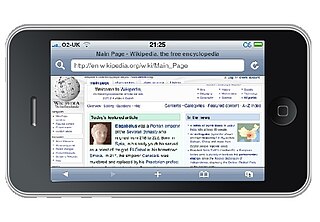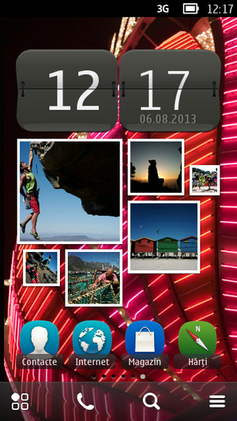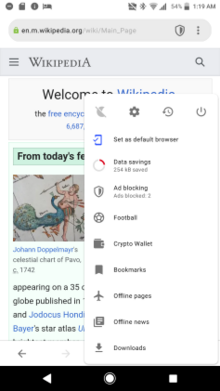
Maxthon is a freeware web browser, created by JeffChen in Singapore. It is available for Windows, macOS, Linux, and as Maxthon Mobile for Android, iOS, and Windows Phone 8. Since version 6, Maxthon is based on Chromium.
Presto was the browser engine of the Opera web browser from the release of Opera 7 on 28 January 2003, until the release of Opera 15 on 2 July 2013, at which time Opera switched to using the Blink engine that was originally created for Chromium. Presto was also used to power the Opera Mini and Opera Mobile browsers.

A mobile browser is a web browser designed for use on a mobile device such as a mobile phone, PDA, smartphone, or tablet. Mobile browsers are optimized to display web content most effectively on small screens on portable devices. Some mobile browsers, especially older versions, are designed to be small and efficient to accommodate the low memory capacity and low bandwidth of certain wireless handheld devices. Traditional smaller feature phones use stripped-down mobile web browsers; however, most current smartphones have full-fledged browsers that can handle the latest web technologies, such as CSS 3, JavaScript, and Ajax.
Nokia Series 40, often shortened as S40, is a software platform and application user interface (UI) software on Nokia's broad range of mid-tier feature phones, as well as on some of the Vertu line of luxury phones. It was one of the world's most widely used mobile phone platforms and found in hundreds of millions of devices. Nokia announced on 25 January 2012 that the company has sold over 1.5 billion Series 40 devices. It was not used for smartphones, with Nokia turning first to Symbian, then in 2012–2017 to Windows Phone, and most recently Android. However, in 2012 and 2013, several Series 40 phones from the Asha line, such as the 308, 309 and 311, were advertised as "smartphones" although they do not actually support smartphone features like multitasking or a fully fledged HTML browser.
Nokia Browser for Symbian was the default web browser for the S60 and Symbian mobile phone platform. The browser is based on a port of Apple Inc.'s open-source WebCore and JavaScriptCore frameworks which form the WebKit rendering engine that Apple uses in its Safari Web browser.
The mobile web comprises mobile browser-based World Wide Web services accessed from handheld mobile devices, such as smartphones or feature phones, through a mobile or other wireless network.

The history of the Opera web browser began in 1994 when it was started as a research project at Telenor, the largest Norwegian telecommunications company. In 1995, the project branched out into a separate company named Opera Software ASA, with the first publicly available version released in 1996. Opera has undergone extensive changes and improvements, and introduced notable features such as Speed Dial.

Opera Mobile is a mobile web browser for smartphones, tablets and PDAs developed by Opera.

Wireless Application Protocol (WAP) is an obsolete technical standard for accessing information over a mobile cellular network. Introduced in 1999, WAP allowed users with compatible mobile devices to browse content such as news, weather and sports scores provided by mobile network operators, specially designed for the limited capabilities of a mobile device. The Japanese i-mode system offered a competing wireless data standard.
The Pogo Mobile was a GSM-based mobile device developed by British start-up Pogo Technology Ltd. It combined web browsing, messaging, audio playback and phone functionality in a portable form.
This page is a comparison of notable remote desktop software available for various platforms.

ThunderHawk is a discontinued web browser from Bitstream available for a full range of operating systems in high end and mass-market mobile phones and personal digital assistants. It is basically meant for mobile operators and original equipment manufacturers and not meant to download for normal users.

Ovi was the brand for Nokia's Internet services from 2007 to 2012. It was designed to be an umbrella brand as Nokia attempted to expand into software and Internet services instead of just mobile hardware. Ovi focused on five key service areas offered by Nokia: Games, Maps, Media, Messaging and Music.
Mobile web analytics studies the behaviour of mobile website users in a similar way to traditional web analytics. In a commercial context, mobile web analytics refers to the data collected from the users who access a website from a mobile phone. It helps to determine which aspects of the website work best for mobile traffic and which mobile marketing campaigns work best for the business, including mobile advertising, mobile search marketing, text campaigns, and desktop promotion of mobile sites and services.

UC Browser is a web browser developed by mobile internet company UCWeb, a subsidiary of the Alibaba Group. It was the most popular mobile browser in India, Indonesia, and Mali, as well as the second-most popular one in China as of 2017. Its world-wide browser share as of May 2022 is 0.86% overall according to StatCounter.

The BOLT Browser was a web browsing system for mobile phones including feature phones and smartphones able to run Java ME applications. The BOLT browser was installed on the phone, and BOLT servers accessed Web pages, processed and compressed them, and delivered them to phones running the browser. The BOLT Browser was offered free of charge to consumers, and by license to mobile network operators and handset manufacturers. BOLT was produced by Bitstream Inc., the company which previously produced ThunderHawk for mobile network operators and handset manufacturers. BOLT was originally introduced into private beta on January 15, 2009 and was made available to the public on February 16, 2009 when the public beta was announced at Mobile World Congress in Barcelona. BOLT supported Java-based handsets with Java MIDP 2 and CLDC 1.0 or higher. BOLT also has specially optimized version for BlackBerry smartphones and worked with Windows Mobile and Palm OS devices that employ a MIDlet manager or Java emulator. BOLT was built using the WebKit rendering engine to display a full Web page layout as found on desktop web browsers.

Symbian was a mobile operating system (OS) and computing platform designed for smartphones. It was originally developed as a proprietary software OS for personal digital assistants in 1998 by the Symbian Ltd. consortium. Symbian OS is a descendant of Psion's EPOC, and was released exclusively on ARM processors, although an unreleased x86 port existed. Symbian was used by many major mobile phone brands, like Samsung, Motorola, Sony Ericsson, and above all by Nokia. It was also prevalent in Japan by brands including Fujitsu, Sharp and Mitsubishi. As a pioneer that established the smartphone industry, it was the most popular smartphone OS on a worldwide average until the end of 2010, at a time when smartphones were in limited use, when it was overtaken by iOS and Android. It was notably less popular in North America.
Microsoft mobile services are a set of proprietary mobile services created specifically for mobile devices; they are typically offered through mobile applications and mobile browser for Windows Phone platforms, BREW, and Java. Microsoft's mobile services are typically connected with a Microsoft account and often come preinstalled on Microsoft's own mobile operating systems while they are offered via various means for other platforms. Microsoft started to develop for mobile computing platforms with the launch of Windows CE in 1996 and later added Microsoft's Pocket Office suite to their Handheld PC line of PDAs in April 2000. From December 2014 to June 2015, Microsoft made a number of corporate acquisitions, buying several of the top applications listed in Google Play and the App Store including Acompli, Sunrise Calendar, Datazen, Wunderlist, Echo Notification Lockscreen, and MileIQ.
Opera Mobile Store was a platform-independent browser-based app store for mobile-phone owners and a digital application distribution platform used by more than 40,000 developers. It is owned and maintained by Opera. Launched by a third-party provider in March 2011, the Opera Mobile Store was relaunched on a new platform, after acquisition of Handster, a mobile app store platform company, in January 2012. The service allows users to browse and download applications for over 7,500 different devices on Android, Java, BlackBerry OS, Symbian, iOS, and Windows Mobile.
Nokia Xpress is a discontinued mobile browser developed by Nokia and supported by Microsoft until the end of 2015. It came loaded by default with Series 40, Asha Platform and Nokia X Software Platform. It uses the Gecko rendering engine. On Nokia feature phones it was replaced by Opera browser in early 2015.










